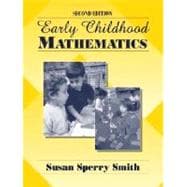
Most chapters conclude with “Summary,” “Activities and Study Questions,” “Further Reading,” “Related Children's Literature,” “Links to Technology,” and “References.”
Preface.
Acknowledgements.
1. Mathematics and You.
How You Were Taught: Then and Now.
Math Anxiety—You Can Handle It.
Ten Myths about Teaching Mathematics to All Children.
Success for Every Child.
The Eight Intelligences.
Serving Children in Inclusive Settings.
The Child Who Is Gifted.
The Child with Learning Disabilities.
The Child Who Is Cognitively Disabled (Children with Mental Retardation).
Where We Are Going—The NCTM Standards.
Developmentally Appropriate Education: Creating the Best Learning Environment.
Piaget, Vygotsky, Bruner, and Dienes.
2. The Language of Math.
Developing Math and Language Using Song and Verse.
Developing Math Language through Children's Literature.
Math Language and Older Children.
Math Concepts Found in the Early Childhood Curriculum.
The Symbols of Math.
The Number Sentence.
3. Early Math Concepts: Matching, Classification, Comparing, and Ordering or Seriation.
Matching.
Matching: Informal Learning around Home and School.
Assessment of Matching Abilities.
Early Classification—Creating Sets.
Children and Sets: Informal Learning around Home and School.
Classroom Activities Involving Sets.
Complex Classification.
Assessment of the Relationship Involving Classification.
Comparing.
Comparing: Informal Learning around Home and School.
Ordering or Seriation.
Ordering or Seriation: Informal Learning around Home and School.
Assessment of Relationships Involving Ordering.
4. Space and Shape.
Space: Informal Learning at Home and School.
Assessment of Spatial Relationships.
The Art of Block Building.
Blocks for Girls as Well as Boys.
Shape.
Shape: Informal Learning around Home and School.
Planning Activities about Shape.
Assessment of Shape.
Geometric Concepts in the Early Grades.
5. Pattern and Function.
The Importance of Pattern.
Principles of Pattern.
Early Classroom Activities.
Pattern in Music and Art.
Functions in the Primary Grade Classroom.
6. Graphing.
Topics for Graphing Experiences.
The Challenge in Reading Graphs.
The Graphing Questions.
Early Experiences with Graphing.
Choosing Categories That Avoid Hurt Feelings or Wanting to Be on the Winning Side.
Probability.
7. Developing Number Sense.
A Cultural Perspective.
Counting: The Young Child Plays and Learns.
Research and Today's Classroom.
Piaget's Tests of Conservation.
Guided Learning Activities.
Counting-On Activities.
Counting-Back Activities.
From Counting to Part-Part-Whole Activities.
Thinking in Groups.
Reading and Writing Numerals.
Fractions and Number Sense.
8. Problem Solving—Addition and Subtraction.
Math Is Problem Solving.
Choosing a Problem.
General Kinds of Problems.
Problem Posing.
A Positive Environment.
General Strategies.
Cognitive Background Information for Teachers: Classes of Problems.
Rules of Operation.
Helping Children Write Their Own Problems.
Using What Children Know to Learn the Facts.
9. Understanding Our Place Value System.
A Brief History of Base-Ten.
The Unique Features of the Base-Ten System.
Readiness for Place Value.
Children's Natural Preferences.
Classroom Learning with Manipulatives.
Teaching with Bean Sticks or Base-Ten Blocks.
Teaching with the Abacus and Money.
Estimating and Rounding Larger Numbers.
Assessing Children's Understanding of Place Value.
10. Measurement.
Definition.
Principles of Measurement.
The General Method.
The Young Child Plays and Learns.
Two Measurement Systems.
Difficulties in the Measurement Process.
Guided Learning—Physical Quantities.
Guided Learning—Non-Physical Quantities.
11. Problem Solving—Multiplication and Division.
Definition.
Readiness for Multiplication and Division.
Children's Natural Strategies.
Cognitive Background for Teachers: Classes of Problems.
Remainders.
Illustrations.
Linking Problem Solving to Symbolic Representation.
Rules of Operation.
The Role of Zero.
Helping Children Write Their Own Problems.
12. Assessment.
Assessment and Evaluation Defined.
Curriculum Reform and Alignment.
Assessment Strategies.
Scoring Methods.
Alternatives for Students.
Record Keeping.
13. Planning for Success: A Good Beginning.
How Do I Get Started?
How Can I Involve Parents in My Program?
What Should I Do if My Students Have Had Only Rote Math Background?
How Can I Meet the Needs of Children from Diverse Backgrounds?
How Can I Use Technology to Enhance Learning?
Planning for Computer-Assisted Instruction.
Choosing Appropriate Software.
Planning for Calculators.
14. Thematic Units.
All about Bears (Preschool).
The Circus (Preschool-Kindergarten).
Insects (Preschool-Kindergarten).
Peter Rabbit (First and Second Grade).
Appendix A: Software Companies.
Index.
The New copy of this book will include any supplemental materials advertised. Please check the title of the book to determine if it should include any access cards, study guides, lab manuals, CDs, etc.
The Used, Rental and eBook copies of this book are not guaranteed to include any supplemental materials. Typically, only the book itself is included. This is true even if the title states it includes any access cards, study guides, lab manuals, CDs, etc.